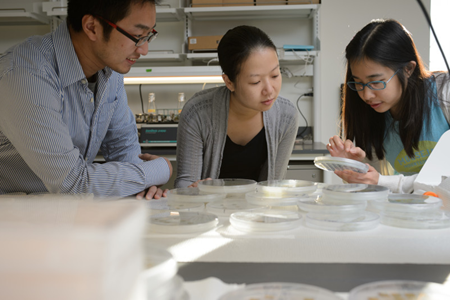|
刊登在国际杂志PNAS上的一篇研究论文中,来自密歇根州立大学的科学家通过研究发现了一种细胞睡眠按钮,其或许可以帮助有效改善生物燃料的产量以及指示早期癌症的发病征兆。这种名为CHT7的蛋白就好比细胞静止状态的阻遏子,这种细胞开关可以影响藻类的生长及油料的产量,同时其也是控制人类机体肿瘤生长的关键蛋白。
研究者Benning表示,藻类可以为我们提供许多有竞争价值超过酵母模型的新型模式生物,在实验室的小管中生长许多不同类型的人类细胞是相当困难的,然而通过一定的控制,藻类就可以达到上述目的,而且藻类也具有完整的基因组特性,可以为开发治疗人类疾病的药物提供一定的平台和基础。
当细胞处于压力环境中产油只是其生存的部分策略,这时候处于静息状态下的细胞往往会储存更多的能量和营养物,当将能量和营养物转化成为真正的生物燃料时,需要让细胞生长并且同时刺激其产油。本文中研究人员发现的CHT7蛋白可以使得细胞“清醒”过来,通过对CHT7蛋白进行工程化操作,研究人员未来就有可能开发出一种特殊的有机体,这种有机体将会一直持续激活,不断产生高质量的生物燃料。
本文研究对于开发治疗人类疾病的药物也带来了巨大帮助,其可以为研究人员提供一种新型模型来研究肿瘤的抑制及生长,由于休眠细胞往往是在许多植物和动物机体中发现,而其正为研究有机体细胞行为的调节机制提供了很好的模型和基础,比如研究人类机体的许多疾病发病机制,这在一定程度上是目前酵母模型无法复制的。
最后研究者Benning说道,CHT7蛋白将为癌症领域研究开辟一片新的天地,这种分子开关会促使有机体无限生长,后期研究中我们或许会通过CHT7蛋白来研究癌症扩散及肿瘤无限增殖的分子机制。
The protein Compromised Hydrolysis of Triacylglycerols 7 (CHT7) acts as a repressor of cellular quiescence in Chlamydomonas
Chia-Hong Tsaia,b, Jaruswan Warakanontb, Tomomi Takeuchic, Barb B. Searsb, Eric R. Moelleringc,1, and Christoph Benningc,2
Microalgae are prolific photosynthetic organisms that have the potential to sustainably produce high-value chemical feedstocks. However, an industry based on microalgal biomass still is faced with challenges. For example, microalgae tend to accumulate valuable compounds, such as triacylglycerols, only under stress conditions that limit growth. To investigate the fundamental mechanisms at the base of this conundrum—the inverse relationship between biomass production and storage compound accumulation—we applied a combination of cell biological and genetic approaches. Conceptually, nutrient deprivation, which commonly is used to induce the accumulation of triacylglycerol in microalgae, leads to a state of cellular quiescence defined by a halt of cell divisions that is reversible upon nutrient resupply. To identify factors that govern cellular quiescence, we screened for mutants of the model alga Chlamydomonas reinhardtii that, in contrast to wild-type cells placed under conditions of nitrogen deprivation, were unable to degrade triacylglycerols following nitrogen resupply. One of the mutants described here in detail, compromised hydrolysis of triacylglycerols 7 (cht7), was severely impaired in regrowth following removal of different conditions inducing cellular quiescence. The mutant carries a deletion affecting four genes, only one of which rescued the quiescence phenotype when reintroduced. It encodes a protein with similarity to mammalian and plant DNA binding proteins. Comparison of transcriptomes indicated a partial derepression of quiescence-related transcriptional programs in the mutant under conditions favorable to growth. Thus, CHT7 likely is a repressor of cellular quiescence and provides a possible target for the engineering of high-biomass/high-triacylglycerol microalgae. (责任编辑:泉水) |
PNAS:科学家发现促进癌症恶化的细胞“睡眠按钮”
时间:2014-10-20 13:09来源:生物谷 作者:未知 点击:
142次
顶一下
(0)
0%
踩一下
(0)
0%
------分隔线----------------------------
- 发表评论
-
- 最新评论 进入详细评论页>>
- 推荐内容
-
- 科学家在临床研究中开发出可杀死
美国最大的癌症研究和治疗机构之一希望之城(City of Hope)的研...
- 研究利用人体自身免疫细胞对抗脑
胶质母细胞瘤是最常见也是最致命的脑癌,它生长迅速,侵袭并...
- 科学家发现对50%癌细胞有效的细胞
斯坦福大学的科学家们发现了一种诱导癌细胞死亡的方法,这种...
- 超声波可能协助化疗药物通过血脑
破解脑癌治疗的密码可能要从破解大脑的保护罩开始。 大脑的大...
- 2018或将开启中国肿瘤免疫治疗新元
NGS作为一项重大的技术突破,从2010年前后开始肿瘤治疗的临床转...
- 新方法可提前诊断乳腺癌
癌症早期诊断对治疗非常重要。英国伦敦大学学院近日发表一项...
- 科学家在临床研究中开发出可杀死

